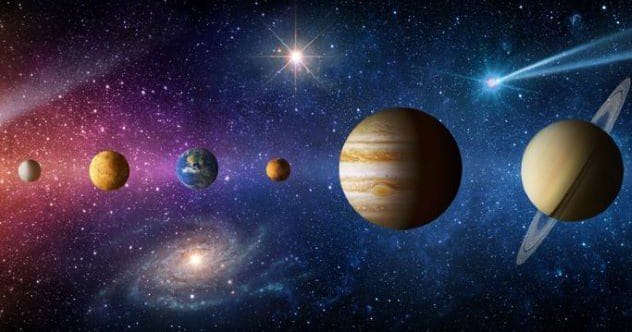Have you ever gazed up at the twinkling night sky and wondered about the vast universe? It’s a place full of mystery! Movies and books often spark our imagination, but sometimes they lead to some common misunderstandings. Let’s dive into science and clear up ten popular myths about our amazing universe.
10 Myth: Stars We See Are Mostly Dead
It’s a common thought: light from stars takes ages to reach us, so many stars we see must have already burned out. Is this true?
Actually, not quite. The roughly 6,000 stars visible to our naked eye are all relatively close, less than 1,000 light-years away. Light travels incredibly fast, at about 186,000 miles per second (or 300,000 kilometers per second). So, the light from these stars doesn’t take that long to reach Earth. It’s highly unlikely that any star we can see has died in the time its light has taken to travel to us. They are most likely still shining brightly!
9 Myth: The Universe Is Infinite
The universe is unbelievably big, there’s no question about that! But does it go on forever? Surprisingly, science suggests it doesn’t.
Our own galaxy, the Milky Way, contains over 200 billion stars. And scientists estimate there are about two trillion galaxies in the observable universe! Yet, it’s still measurable. The edge of the observable universe is about 47 billion light-years away from us in every direction. This means the universe has a diameter of about 94 billion light-years. It’s mind-boggling to think about, and it makes you wonder: what could possibly be beyond that edge?
8 Myth: Black Holes Are Giant Cosmic Vacuums
Movies often show black holes as hungry monsters, sucking up everything in their path like a giant vacuum cleaner. But is that how they really work?
Black holes aren’t on a mission to gobble up planets. They form when huge stars run out of fuel and collapse under their own gravity. This collapse makes the star incredibly dense, creating super strong gravity. This gravity can pull in nearby objects, even light, if they get too close to the event horizon (the point of no return). However, this gravity is just regular gravity, only much stronger because of the density. For example, if a star ten times bigger than our sun became a black hole, its gravity would be the same as a star ten times our sun’s mass. It doesn’t hunt; things just fall in if they wander too close.
7 Myth: Dark Matter Is Evil and Destructive
Dark matter often appears in sci-fi stories as something mysterious and sometimes even sinister. But is it really a force of evil?
Not at all! Dark matter is completely invisible; scientists have never directly seen or detected it. Yet, it makes up about 27% of all the matter in the universe. Think of it as the invisible stuff filling the vast spaces between stars and galaxies. Most scientists believe dark matter is made of particles called WIMPs (Weakly Interacting Massive Particles). These particles are thought to be much heavier than protons but interact so weakly with normal matter that they are incredibly hard to find, hence the name “dark.”
6 Myth: Earth-Like Planets Are Very Rare
We know Proxima Centauri b is the closest potentially habitable planet, just four light-years away. But even with our current technology, it would take over 60,000 years to get there! Does this mean planets like Earth are hard to find?
Let’s not confuse how close they are with how many there might be. Astronomers estimate there could be anywhere from 300 million to 6 billion Earth-like planets just in our Milky Way galaxy! And with trillions of galaxies out there, scientists think there could be as many as 76 sextillion (that’s 76 followed by 21 zeros!) stars similar to our sun, each potentially having planets where life could exist. So, Earth-like planets might be quite common!
5 Myth: We’ll Soon Travel at Light Speed Between Galaxies
Warp speed and hyperdrives make for exciting space travel in movies, letting characters zip across galaxies in no time. But is traveling at the speed of light, or even close to it, possible in reality?
Unfortunately, Einstein’s Theory of Relativity throws a wrench in those plans. It states that as an object speeds up, its mass increases. So, if something tried to accelerate to near light speed, its mass would become infinitely large, requiring an infinite amount of energy to move it. This simply can’t happen. While tiny particles without mass, like photons, can travel at light speed, anything with mass (like a spaceship or a person) cannot. So, zipping around galaxies at light speed will likely remain in the realm of science fiction.
4 Myth: The Big Bang Was a Giant Explosion
The name itself, “The Big Bang Theory,” sounds like a massive explosion started everything. But did the universe really begin with a cosmic boom?
Cosmologists often try to clarify this. Scientists generally agree that the universe began about 13.8 billion years ago from an incredibly small, dense point. But it wasn’t an explosion like a bomb going off. Instead, it was a rapid expansion of space itself, happening faster than the speed of light. This means everything is still roughly in the same position it was back then; it’s the space between objects that’s stretching and growing. This also explains why there isn’t an empty void at the center of the universe, which you’d expect if everything blasted out from one spot.
3 Myth: Aliens Could Easily Visit Earth
With so many UFO sightings reported, it might seem possible that aliens could pop over for a visit. If even a few sightings were real, wouldn’t that mean alien visitors are a real possibility?
Let’s look at the numbers again. With potentially sextillions of habitable planets, there’s a very strong chance that life exists elsewhere—some perhaps even intelligent and advanced. But could they travel to Earth? Our Milky Way galaxy alone is 100,000 light-years across. Alien civilizations would face the same huge challenges of space travel we do: immense distances, the need for food and fuel, and protection from radiation. The fastest human-made object, the Voyager spacecraft, travels at 11 miles per second. Even at that speed, it would take 73,000 years to reach the nearest star system. Imagine a journey lasting millions of years! It seems unlikely any beings could survive such a trip.
2 Myth: In Space, No One Can Hear You Scream
This famous movie tagline suggests that since space is a vacuum, sound waves can’t travel, so a scream would be silent. It makes sense, right?
Well, NASA researchers have found it depends on where you are in space. While much of space is a near-perfect vacuum, some areas are not. For instance, scientists studying a huge, gas-rich black hole in the Perseus cluster, about 250 million light-years away, detected eerie sounds. These sounds were pressure waves traveling through the hot gas. So, if you happened to be in an area of space filled with dense gases, plasma, or other particles, your scream might actually be heard! You wouldn’t be wasting your breath after all.
1 Myth: Our Sun Is a Giant Ball of Fire
When we think of the sun, we often picture a giant fireball blazing in the sky. Is it really just burning like a huge bonfire?
Actually, it’s much more like an ongoing series of countless hydrogen bomb explosions. Deep in the sun’s core, hydrogen atoms smash into each other and fuse to become helium atoms. This process, called nuclear fusion, releases enormous amounts of energy—similar to how a nuclear power plant works. These reactions have been powering our sun for about four billion years! Thankfully, the sun’s incredible density and gravity are strong enough to hold all this energy together and prevent it from actually blowing itself up. It’s a perfectly balanced nuclear furnace.
The universe is a fascinating place, full of wonders that often challenge our everyday understanding. By looking at the science, we can appreciate its true nature even more. It’s always exciting to learn what’s real and what’s just a popular story!
What other space myths have you heard? Share your thoughts and questions in the comments below!










